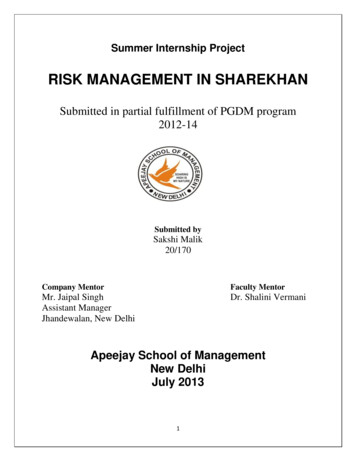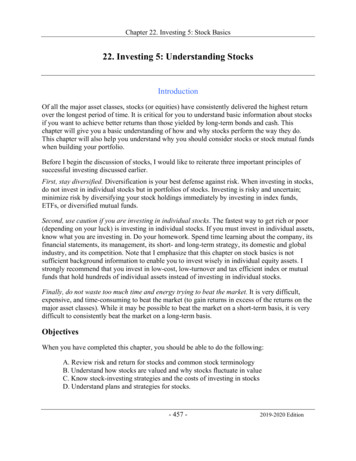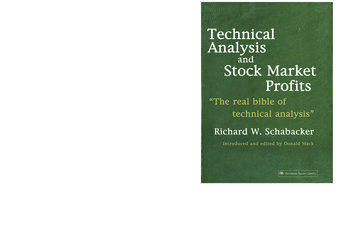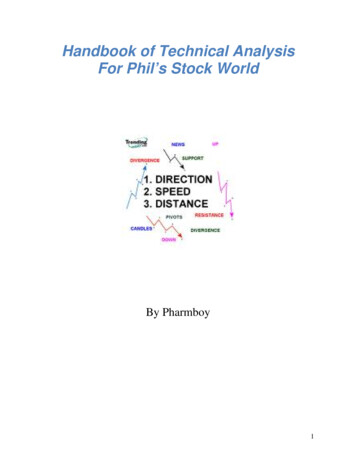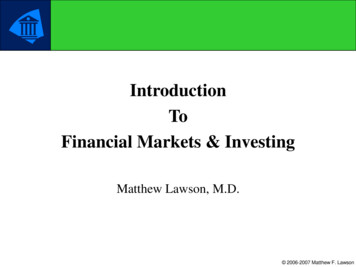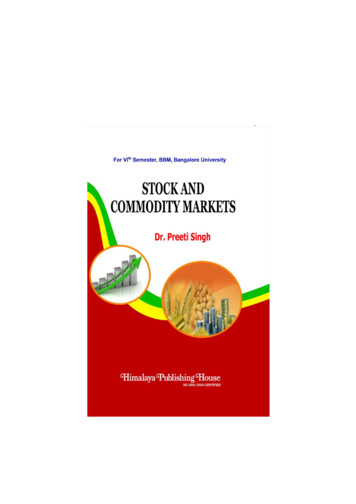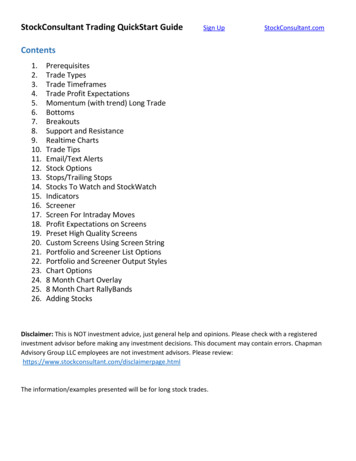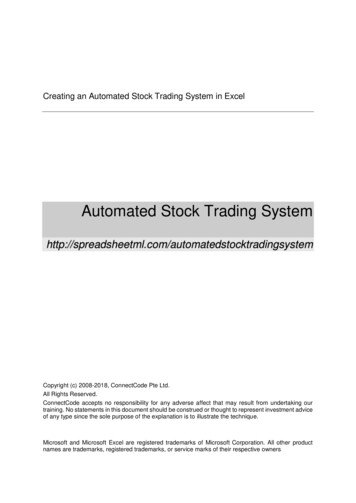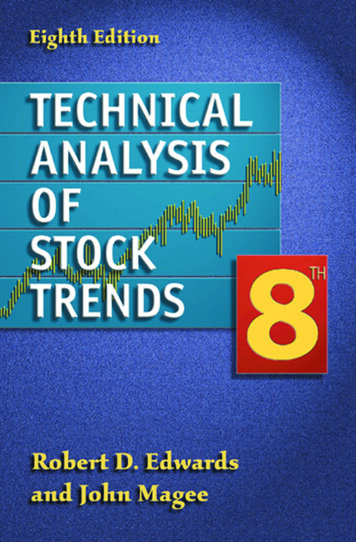
Transcription
70 DVD’s FOR SALE & dreybbrv@yandex.ruSkype: andreybbrv
EIGHTHEDITIONTECHNICAL ANALYSISOFSTOCK TRENDS
TechnicalAnalysis ofStock Trends8th EditionRobert D. EdwardsJohn MageeandEditor and Co-Author of the 8th EditionW.H.C. BassettiAdjunct ProfessorDepartment of Finance and EconomicsGolden Gate UniversitySan Francisco
Library of Congress Cataloging-in-Publication DataEdwards, Robert D. (Robert Davis), 1893–1965Technical analysis of stock trends / by Robert D. Edwards, John Magee, and W.H.C.Bassetti.—8th ed.p. cm.Includes bibliographical references and index.ISBN 1-57444-292-9 (alk. paper)1. Investment analysis. 2. Stock exchanges—United States. 3. Securities—United States.I. Magee, John. II. Bassetti, W. H. C. III. Title.HG4521 .E38 2001332.63′2′0420973—dc2100-068427Catalog record is available from the Library of CongressThis book contains information obtained from authentic and highly regarded sources. Reprinted materialis quoted with permission, and sources are indicated. A wide variety of references are listed. Reasonableefforts have been made to publish reliable data and information, but the author and the publisher cannotassume responsibility for the validity of all materials or for the consequences of their use.Neither this book nor any part may be reproduced or transmitted in any form or by any means, electronicor mechanical, including photocopying, microfilming, and recording, or by any information storage orretrieval system, without prior permission in writing from the publisher.The consent of CRC Press LLC does not extend to copying for general distribution, for promotion, forcreating new works, or for resale. Specific permission must be obtained in writing from CRC Press LLCfor such copying.Direct all inquiries to CRC Press LLC, 2000 N.W. Corporate Blvd., Boca Raton, Florida 33431.Trademark Notice: Product or corporate names may be trademarks or registered trademarks, and areused only for identification and explanation, without intent to infringe.Dow–JonesSM, The DowSM, Dow–Jones Industrial AverageSM, and DJIASM are service marks of Dow–Jones & Company, Inc., and have been licensed for use for certain purposes by the Board of Trade ofthe City of Chicago (CBOT ). The CBOT’s futures and future options contracts based on the Dow–JonesIndustrial AverageSM are not sponsored, endorsed, sold, or promoted by Dow–JonesSM, and Dow–JonesSMmakes no representation regarding the advisability of trading in such products.Visit the CRC Press Web site at www.crcpress.com 2001 by CRC Press LLCSt. Lucie Press is an imprint of CRC Press LLCNo claim to original U.S. Government worksInternational Standard Book Number 1-57444-292-9Library of Congress Card Number 00-068427Printed in the United States of America 1 2 3 4 5 6 7 8 9 0Printed on acid-free paper
Preface to the Eighth EditionHere is a strange event. A book written in the mid-20th century retains itsrelevancy and importance to the present day. In fact, Technical Analysis ofStock Trends remains the definitive book on the subject of analyzing the stockmarket with charts. Knock-offs, look-alikes, pale imitations have proliferatedin its wake like sea gulls after a productive fishing boat. But the truth is,they have added nothing new to the body of knowledge Edwards and Mageeoriginally produced and Magee refined up to the 5th edition.What accounts for this rare occasion of a book’s passing to be a classic?To be more, in fact, than a classic, to be the manual or handbook for currentusage?To answer this question we must ask another. What are Chart formations? Chart formations identified and analyzed by the authors are graphicrepresentations of unchanging human behavior in complex multivariatesituations.They are the depiction of multifarious human actions bearing on a singlevariable (price). On price converge a galaxy of influences: fear, greed, desire,cunning, malice, deceit, naivete, earnings estimates, broker need for income,gullibility, professional money managers’ need for performance and jobsecurity, supply and demand of stocks, monetary liquidity and money flow,self-destructiveness, passivity, trap setting, manipulation, blind arrogance,conspiracy and fraud and double dealing, phases of the moon and sun spots,economic cycles and beliefs about them, public mood, and the indomitablehuman need to be right.Chart formations are the language of the market, telling us that this stockis in its death throes; that stock is on a rocket to the moon; that a life anddeath battle is being waged in this issue; and in that other, the buyers havedefeated the sellers and are breaking away.They are, in short, the unerasable fingerprints of human nature madegraphic in the greatest struggle, next to war, in human experience.As Freud mapped the human psyche, so have Edwards and Mageemapped the human mind and emotions as expressed in the financial markets.Not only did they produce a definitive map, they also produced a methodology for interpreting and profiting from the behavior of men and markets.It is difficult to imagine further progress in this area until the science ofartificial intelligence, aided by yet unimaginable computer hardware, makesnew breakthroughs.If It Is Definitive, Why Offer a New Edition?Unlike Nostradamus and Jules Verne (and many current investment advisors), the authors did not have a crystal ball or a time machine. Magee did
not foresee the electronic calculator and made do with a slide rule. And whilehe knew of the computer, he did not anticipate that every housewife andinvestor would have 1000 times the power of a Whirlwind or Univac I onhis (her) desk (cf. Note on Gender). In short, the March of Time. The Progressof Science. The Inexorable Advance of Technology.Amazingly, the great majority of this book needed no update or actualization. Who is to improve on the descriptions of chart formations and theirsignificance?But insofar as updates are necessary to reflect the changes in technologyand in the character and composition of the markets, that is another story.Human character may not change, but in the new millennium there is nothingbut change in the character and composition of the markets. And while regulatory forces might not be completely in agreement, the majority of thesechanges have been positive for the investor and the commercial user. Of course,Barings Bank and some others are less than ecstatic with these developments.An Outline of the Most Important Additions Madeto This Book to Reflect Changes in the Times,Technology, and MarketsGenerally speaking, these additions, annotations, and updates are intendedto inform the general reader of conditions of which he must be aware forinvesting success. In most cases, because of the enormous amount of material, no attempt is made to be absolutely exhaustive in the treatment of thesedevelopments. Rather the effort is made to put changes and new conditionsin perspective and furnish the investor with the resources and proper guideto pursue subjects at greater length if desired. In fact, an appendix has beenprovided, entitled Resources, to which the reader may turn when he hasmastered the material of the book proper.The stubborn individualist may realize investment success with the useof this book alone (and paper, pencil, ruler, and chart paper (cf. Section onTekniplat chart paper).TechnologyIn order to equip this book to serve as a handbook and guide for the marketsof the new millennium, certain material has been added to the text of the5th and 7th editions. Clearly the astounding advances in technology mustbe dealt with and put in the context of the analytical methods and materialof the original. To achieve success in the new, brave world, an investor mustbe aware of and utilize electronic markets, the Internet, the microcomputer,wireless communications, and new exchanges offering every kind of exoticaimaginable.The advanced investor should also be aware of and understand someof the developments in finance and investment theory and technology — the
Black–Scholes Model, Modern Portfolio Theory, Quantitative Analysis. Fortunately, all these will not be dealt with here, because in truth one intelligentinvestor with a piece of chart paper and a pencil and a quote source can dealwith the markets, but that is another story we will explore later in the book.Some of these germane subjects will be discussed sufficiently to put themin perspective for the technical analyst, and then guides and resources willbe pointed out for continued study. My opinion is that the mastery of allthese subjects is not wholly necessary for effective investing at the privatelevel. What need does the general investor have for an understanding of theCox–Ross–Rubinstein options analysis model to recognize trends? The Edwards–Magee model knows things about the market the CRR model doesnot.Trading and Investment InstrumentsThe new universe of available trading and investment instruments must betaken into account. The authors would have been in paradise at the profusionof alternatives. In this future world, they could have traded the Averages(one of the most important changes explored in this book); used futures andoptions as investment and hedging mechanisms; practiced arbitrage strategies beyond their wildest dreams; and contemplated a candy store full ofinvestment products. The value and utility of these products would havebeen immeasurably enhanced by their mastery of the charting world oftechnical analysis. As only one example, one world-prominent professionaltrader I know has made significant profits selling calls on stocks he correctlyanalyzed to be in down trends, and vice versa — an obvious (or, as they say,no-brainer) to a technician, but not something you should attempt at homewithout expert advice. Techniques like this occasioned the loss of manymillions of dollars in the Reagan Crash of 1987.Changes and Developments in Technical AnalysisHave any new chart patterns (that is to say, changes in human behavior andcharacter) emerged since the 5th edition? Not to my knowledge, althoughthere are those who take the same data and draw different pictures fromthem. How else could you say that you had something new! different! better!?There are other ways of looking at the data which are interesting, sometimesvaluable, and often profitable, which goes to prove that many are the waysand gateless is the gate to the great Dow. Point and figure charting havebeen used very effectively by traders I know, and candlestick charting depictsdata in interesting ways. Furthermore, since Magee’s time, aided by thecomputer, technicians have developed innumerable, what I call, numberdriven technical analysis tools: (the puzzlingly named) stochastics, oscillators, exponential and other moving averages, etc., etc., etc. It is not the intentof this book to explore these tools in depth. That will be done in a later
volume. These concepts are briefly explored in an appendix supplied byRichard McDermott, editor of the 7th edition.I have also made additions to the book (Chapter 18.1) to give a perspective on long-term investing, since Magee specifically addressed the secondpart of the book (on tactics) to the speculator. I have substantially rewrittenChapters 24 and 42 to reflect current ideas on portfolio management andrisk management. I have expanded on the idea of rhythmic trading — anidea which is implicit in the original. I have expanded the treatment ofrunaway markets so that the Internet stocks of the 1990s might be put inperspective (Chapter 23).And then, paradigms. Paradigms, as everyone should know by now, arethe last refuge of a fundamentalist when all other explanations fail.Paradigm ChangesWhenever the markets, as they did at the end of the 20th century, departfrom the commonly accepted algorithms for determining what their pricesought to be, fundamentalists (those analysts and investors who believe theycan determine value from such fixed verities as earnings, cash flow, etc.) areconfronted with new paradigms. Are stock prices (values) to be determinedby dividing price by earnings to establish a reasonable price/earnings (p/e)ratio? Or should sales be used, or cash flow, or the phase of the moon, or —in the late 1990s, should losses be multiplied by price to determine the valueof the stock? Technicians are not obliged to worry about this kind of financiallegerdemain. The stock is worth what it can be sold for today in the market.Next to last and hopefully not least, in the near future the large audiencefor this book and its accumulated wisdom may expect a CD-ROM edition,which should make navigation and study of the book marvelously easy ona computer.The Crystal BallInvestors will get smarter and smarter, starting with those who learn whatthis book has to say. The professionals will stay one step ahead of them,because they are preternaturally cunning and because they spend all theirtime figuring out how to keep ahead of the public, but the gap will narrow.Software and hardware will continue to advance, but not get any smarter.Mechanical systems will work well in some areas, and not in others. Mechanical systems are only as good as the engineer who designs them andthe mechanic who maintains them. Buying systems is buying trouble. Everyone should find his own method (usually some variant of the Magee method,in my opinion). All good things will end. All bad things will end. The bagof tricks with which the insiders bilk the public will get smaller and smaller.New and ingenious procedures will be developed by the insiders. The wellof human naivete is bottomless. For every one educated, a new one will beborn in a New York minute. It is deeply disturbing at the turn of the century
that the owners of the NASDAQ and the NYSE should be thinking of goingpublic. Could there be any more ominous sign that enormous changes areabout to occur?Vigorous development of the systems, methods, procedures, and philosophy outlined in this book is about the only protective shield I know of toguard against inimical change.W.H.C. BassettiSan Geronimo, CaliforniaJanuary 1, 2001
About the Editorial Practicesin This Eighth EditionNeedless to say, one approaches the revision of a classic work with sometrepidation. Every critic and reader has his or her (cf. Note on Gender)opinion as to how revision should be done — whether the authors’ originaltext should be invisibly changed as though they had written the book in2000 instead of 1948 and were omniscient, or whether errors and anachronisms were to be lovingly preserved, or footnoted, or etc., etc. (I havepreserved Magee’s favorite usage of “etc., etc., etc.” against the protestationof generations of English composition teachers because I like its evocationof an ever-expanding universe.)Notwithstanding every reader’s having an opinion, I am certain allcritics will be delighted with the practices followed in this 3rd millenniumedition of the most important book on technical analysis written in the2nd millennium.Integrity of the Original TextBy and large, the 5th edition has been the source of the authors’ originaltext. Amazingly, almost no stylistic or clarifying emendation has been necessary to that edition. This is a tribute to the clarity, style, and content of theoriginal — one might almost say awesome, if the word were not in suchcurrency on “Saturday Night Live” and the “Comedy Channel.” Consideringthat it was written in the middle of the last century, and considering itscomplex subject, and considering that the markets were one tenth of theirpresent complexity, awesome may be the appropriate word. No change orupdate has been necessary to the technical observations and analysis. Theyare as definitive today as they were in 1950.While I have preserved the authors’ original intent and text, I have takenthe liberty of rearranging some of the chapters. Novices wishing to learnmanual charting will find the appropriate chapters moved to appendices atthe back of the book, along with the chapters on Composite Leverage andSensitivity Indexes.About Apparent AnachronismsCritics with limited understanding of long-term trading success may thinkthat discussions of “what happened in 1929” or “charts of ancient historyfrom 1946” have no relevance to the markets of the present millennium. Theywill point out that AT&T no longer exists in that form, that the New Haven
has long since ceased to exist as a stock, that many charts are records of longburied skeletons. This neglects the value of the charts as metaphor. It ignorestheir representations of human behavior in the markets which will be replicated tomorrow in some stock named today.com or willtheynevergetit.com.Even more important, it ignores the significance of the past to trading in thepresent. I cite here material from Jack Schwager’s illuminating book, TheNew Wizards of Wall Street. Schwager, in conversation with Al Weiss: “Precisely how far back did you go in your chart studies?” Answer: “It variedwith the individual market and the available charts. In the case of the grainmarkets, I was able to go back as far as the 1840s.” “Was it really necessaryto go back that far?” Answer: “Absolutely. One of the keys in long-term chartanalysis is realizing that markets behave differently in different economiccycles. Recognizing these repeating and shifting long-term patterns requireslots of history. Identifying where you are in an economic cycle — say, aninflationary phase vs. a deflationary phase — is critical to interpreting thechart patterns evolving at that time.”Identification of Original Manuscript and RevisionsTrue believers (and skeptics) will find here virtually all of the original material written by Edwards and Magee, including their charts and observations on them. Changes and comments introduced by editors since the 5thedition have been rearranged, and, when appropriate, have been identifiedas a revision by that editor.Maintaining this policy, where updates to the present technological context and market reality were necessary, the present editor has clearly identified them as his own work by beginning such annotations with “EN” forEditor’s Note. Figure insertions are identified as “x.1, x.2.”Absolutely Necessary RevisionsNot too long ago my youngest son, Pancho, overheard a conversation inwhich I referred to a slide rule. “What’s a slide rule, Dad?” he asked. Well,needless to say the world has, in general, moved on from the time of Edwardsand Magee when instead of calculators we had slide rules. Where time hasmade the text useless, moot, or irrelevant, that problem has unobtrusivelybeen corrected.Where the passage of time has made the text obsolete, I have eitherfootnoted the anachronism and/or provided a chapter-ending annotation.These annotations are marked in the text with “EN” also. It is absolutelyessential to read the annotations. Failure to do so will leave the readerstranded in the 20th century.In some cases, these annotations amount to new chapters — for example,trading directly in the averages was difficult in Magee’s time. Nowadays ifthere is not a proxy or option or index for some Index or Average or basketof stocks, there will be one in less than a New York minute (which, as
everyone knows, has only 50 seconds). This new reality has resulted in majoradditions to this new edition. These are detailed in the Foreword. Majorchapter additions necessary to deal with developments in technology andfinance theory have been clearly identified as this editor’s work by designating them as interpolations, viz., Chapter 18.1 (with the exception of Chapter 23, which I have surreptitiously inserted).Absolutely Necessary Revisions Which Will Have Arisen inthe Thirty Minutes Since This Editorial Note Was WrittenIn a number of instances, the book relayed information which, in those daysof fixed commissions and monopolistic control by the existing exchanges,remained valid for long periods of time, for instance, brokerage commissionsand trading costs. It is no longer possible to maintain such information in aprinted book because of the rate of change in the financial industry. It mustnow be filed and updated in real time on the Internet. Consequently, readerswill be able to refer to the John Magee Internet site (www.johnmageeta.com)for this kind of ephemeral data. The general importance of the ephemera tothe subject is always discussed.About GenderI quote here from my foreword to the 2nd edition of Magee’s General Semantics of Wall Street, (charmingly renamed according to the current fashions,Winning the Mental Game on Wall Street):About Gender in GrammarIch bin ein feminist. How could any modern man, sonof a beloved woman, husband of an adored woman,and father of a joyful and delightful daughter not be?I am also a traditionalist and purist in matters of usage,grammar, and style. So where does that leave me andmy cogenerationalists, enlightened literary (sigh) men(and women) with regards to the use of the masculinepronoun when used in the general sense to apply tothe neuter situation?In Dictionary of Modern American Usage, Garner notes:‘English has a number of common-sex general words,such as person, anyone, everyone, and no one, but it hasno common-sex singular personal pronouns. Insteadwe have he, she, and it. The traditional approach hasbeen to use the masculine pronouns he and him to coverall persons, male and female alike. . The inadequacyof the English language in this respect becomes apparent
in many sentences in which the generic masculine pronoun sits uneasily.’Inadequate or not it is preferable to s/he/it and otherbastardizations of the English language. (Is it not interesting that “bastard,” in common usage, is neverused of a woman, even when she is illegitimate?) Asfor the legitimacy of the usage of the masculine (actually neuter) pronoun in the generic, I prefer to lean onFowler, who says, ‘There are three makeshifts: first asanybody can see for himself or herself; second, as anybodycan see for themselves; and third, as anybody can see forhimself. No one who can help it chooses the first; it iscorrect, and is sometimes necessary, but it is so clumsyas to be ridiculous except when explicitness is urgent,and it usually sounds like a bit of pedantic humor. Thesecond is the popular solution; it sets the literary man’s(!) teeth on edge, and he exerts himself to give the samemeaning in some entirely different way if he is notprepared to risk the third, which is here recommended.It involves the convention (statutory in the interpretation of documents) that where the matter of sex is notconspicuous or important the masculine form shall beallowed to represent a person instead of a man, or saya man (homo) instead of a man (vir).’Politically correct fanatics may rail, but so are my teethset on edge; thus, I have generally preserved the authors’ usage of the masculine for the generic case. Thisgrammatical scourge will pass and be forgotten, andweak-willed myn (by which I intend to indicate menand women) who pander to grammatical terrorists willin the future be seen to be stuck with malformed styleand sentences no womyn will buy. What would JaneAusten have done, after all?About Gender in InvestorsAs long as we are on the subject of gender, we mightas well discuss, unscientifically, gender in investors.Within my wide experience as a trading advisor, teacher, and counselor, it strikes me that the women investors I have known have possessed certain innateadvantages over the men. I know there are womengamblers. I have seen some. But I have never seen in
the markets a woman plunger (shooter, pyramider,pie-eyed gambler). I have known many men who fitthis description. I have also noted among my studentsand clients that as a group women seem to have morepatience than men as a group. I refer specifically to thepatience that a wise investor must have to allow themarkets to do what they are going to do.These are wholly personal observations. I have madeno study of the question and can’t speak to the entireclass of women investors — and do not personallyknow Barbra Streisand (who I understand is a formidable investor, especially in IPOs). But just as I believethat the world would be better off if more women rancountries and were police officers, I expect that theworld of finance will benefit from the steadily increasing number of women investors and managers.A Crucial Question — Sensitivity Indexes and BetasLong before the investment community had formalized the beta measure —the coefficient measuring a stock’s volatility relative to the market — Mageeand Edwards were computing a Sensitivity Index, which, for all practicalpurposes, was the same thing. Readers interested in this aspect of their workmay find references in Resources which will enable them to obtain betas toplug into the Composite Leverage formula with which Magee intended todetermine risk levels. The old appendix on Sensitivity Indexes has beenconsigned to Appendix A, along with the chapter on Composite Leverage,both originals of which have been emended to reflect current practices infinance theory and practice.Betwixt and Between, 1/8 of a Dollar or 12.5 CentsAs this edition went to press the financial services industry was once againthreatening to implement decimals in stock prices. Pricing in eighths hasendured long past its time because it was in the self-interest of the financialindustry — it allowed brokers and market makers to enforce larger bid–askspreads and fatten their profit margins. The importance for this book, andfor traders, is what will happen as full decimalization occurs. Often in thesepages, Magee will recommend placing a stop 1/8 off the low or high, orplacing progressive near stops in eighths. We do not yet know what thepsychological interval will be in the new era. It may be 12.5 cents, or morepsychologically, 10 cents, or for gaming purposes, 9 or 11 cents. This remainsto be seen. As all the charts in this book are in the old notation that usagehas been preserved in this edition.
The Editorial “I”Readers will quickly note that the “Editorial We” of Edwards and Mageehas been replaced by the first person voice — or, the “Editorial I” or perhapsthe “Professorial I.” Well, there were two of Edwards and Magee, and thereis only one of me. So my text is immediately noticeable as mine, and thereader may discriminate quickly. As for the use of “I” as an expression ofego, the reader is assured that after 40 years in the market the editor has noego left to promote. Perhaps the best way to put the editor’s sense of importance in perspective is to quote Dr. Johnson’s definition of lexicographerfrom his dictionary. Some people might have thought Johnson self-importantin creating the first English dictionary. His definition of his trade put thatright. “Lexicographer: a writer of dictionaries. A harmless drudge.” An editor issomething like the same.As this book goes to the printer, the publisher, recognizing the importance of the work done on this edition, will credit the Editor as co-author ofthe 8th Edition. John Magee would be pleased. We had a cordial master–student relationship, and nothing pleases a Zen master more than to transferthe dharma to a passionate student.
AcknowledgmentsIn General:John Magee, for his ever-patient tutoring.Blair Hull, for teaching me the mercurial nature of options.Bill Dreiss, for teaching the nature of trading systems.Art von Waldburg, ditto.Fischer Black, who should have lived to get the Nobel Prize.Bill Scott, friend and fellow trader.For specific support and assistance in the preparation of this 8th edition:Professor Henry Pruden, Golden Gate University, San Francisco, for invaluable support and advice.Martin Pring; Lawrence Macmillan; Mitch Ackles, Omega Research Corporation; Carson Carlisle; Edward Dobson; David Robinson; Shereen Ash;Steven W. Poser; Lester Loops, late of Hull Trading Company; Tom Shanks,Turtle.At St. Lucie Press, the dedication and support of the publisher, DrewGierman, and Production Associate, Pat Roberson, have been invaluable, ashas been the dedication of Gail Renard, the Production Editor.And special acknowledgment to my Research Assistant, Don CarlosBassetti y Doyle.Special appreciation goes to makers of software packages used in thepreparation of this and previous editions:AIQ SystemsP.O. Box 7530Incline Village, NV 89452702-831-2999www.AIQ.comMetastockEquis International, Inc.3950 S. 700 East, Suite 100Salt Lake City, UT 84107www.equis.comTradestationOmega Research14257 SW 119th AvenueMiami, FL 33186305-485-7599www.tradestation.com
In MemoriamThis book is a memorial for John Magee, who died on June 17, 1987. JohnMagee was considered a seminal pioneer in technical analysis, and his research with co-author, Robert D. Edwards, clarified and expanded the ideasof Charles Dow, who laid the foundation for technical analysis in 1884 bydeveloping the “Averages,” and Richard Schabacker, former editor of Forbesin the 1920s, who showed how the signals, which had been consideredimportant when they appeared in the averages, were applicable to stocksthemselves. The text, which summarized their findings in 1948, was, ofcourse, Technical Analysis of Stock Trends, now considered the definitive workon pattern recognition analysis. Throughout his technical work, John Mageeemphasized three principles: stock prices tend to move in trends; volumegoes with the trend; and a trend, once established, tends to continue in force.A large portion of Technical Analysis of Stock Trends is devoted to thepatterns which tend to develop when a trend is being reversed: Head-andShoulders, Tops and Bottoms, “W” patterns, Triangles, Rectangles, etc. —common patterns to stock market technicians. Rounded Bottoms and Drooping Necklines are some of the more esoteric ones.John urged investors to
Printed on acid-free paper Library of Congress Cataloging-in-Publication Data Edwards, Robert D. (Robert Davis), 1893–1965 Technical analysis of stock trends / by Robert D. Edwards, John Magee, and W.H.C. Bassetti.—8th ed. p. cm. Includes bibliographical references and index. ISBN 1-57444-292-9

